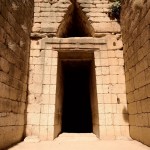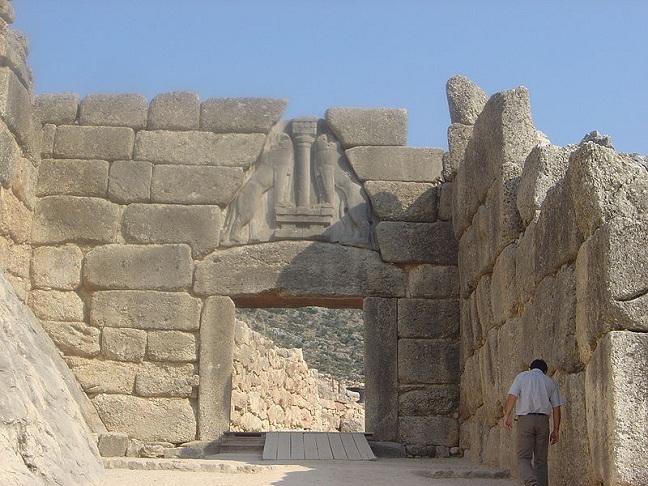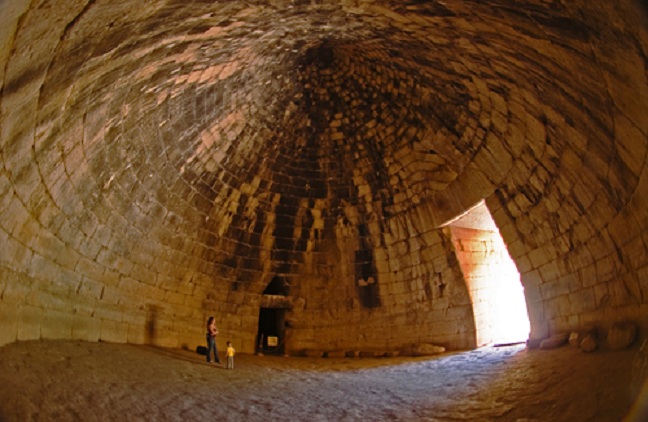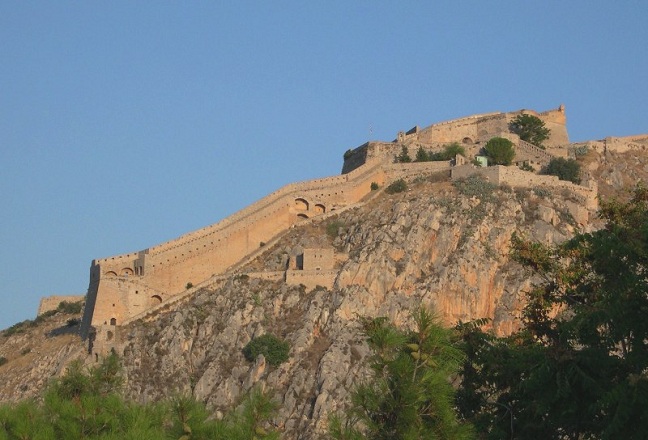 We chose to visit Mycenae during our limited time on the mainland. As the Mycenaeans were the successors (and perhaps conquerors) of the Minoans, their most impressive ruins of were a fitting choice. They are dramatically located on a steep hill, flanked by a deep canyon, from which you can see the entirety of the Argolid plain, and even a fleet approaching by sea would have been visible. The “cyclopean” walls are extremely impressive, many of the blocks weighing over twenty tons. I thought the famous “Gate of the Lions” would be one of those iconic images that disappoints in real life, but it lives up to its reputation. It was visible in historic times without excavation. The excavations and very cautious reconstructions by Greek archaeologists have not involved the laisse-majesté practiced by Evans at Knossos. What you see is largely the citadel as it was in Late Helladic IIIa (circa 1250–1200 BC), open to the public with only enough reconstruction, pathways, fencing and educational plaquing to make it comprehensible to the public and yet keep it from being destroyed by visitors.
We chose to visit Mycenae during our limited time on the mainland. As the Mycenaeans were the successors (and perhaps conquerors) of the Minoans, their most impressive ruins of were a fitting choice. They are dramatically located on a steep hill, flanked by a deep canyon, from which you can see the entirety of the Argolid plain, and even a fleet approaching by sea would have been visible. The “cyclopean” walls are extremely impressive, many of the blocks weighing over twenty tons. I thought the famous “Gate of the Lions” would be one of those iconic images that disappoints in real life, but it lives up to its reputation. It was visible in historic times without excavation. The excavations and very cautious reconstructions by Greek archaeologists have not involved the laisse-majesté practiced by Evans at Knossos. What you see is largely the citadel as it was in Late Helladic IIIa (circa 1250–1200 BC), open to the public with only enough reconstruction, pathways, fencing and educational plaquing to make it comprehensible to the public and yet keep it from being destroyed by visitors.
Tucked away below the citadel is an extremely good museum, with a very high standard of presentation. No hokum, everything very professional. Minoan fans like myself tend to assume that Mycenaean art was a clumsy derivative of their predecessors’ work, but I could not walk away from that museum without acknowledging that these dudes were far from mere war-loving brutes. Some of the artifacts met standards of beauty and craftsmanship as high as anything Minoan.
Despite the chattering tourists, we were carried away by the “sense-of-wonder” feeling of encountering a lost world, and we spent a considerable time poking through every corner of the site. A dramatic, and unanticipated event for us was descending into the fortress’s cistern. This feature does not seem to be publicized, and there is no lighting, but nothing prevents visitors from climbing down into it if they happen to have a flashlight, which, of course, we did. It’s wonderfully creepy, descending a steep gradient of one hundred rather slippery steps, 18 meters down into living rock. When we reached the bottom, we extinguished the light, leaving that total darkness that generates phosphenes in your eyeballs. The rock walls were suitably dank.
We saved the tholos tombs til last. The nine tholoi are near, but not within the fortress. They are saddled with rather embarassing fanciful names: Treasury of Atreus, Tomb of Clytemnestra, etc . They resemble the tholos tombs of Crete in only the most general fashion. Mycenian tholoi were meant to impress. The interior, corbelled vaults give a cathedral-like feeling, and the exterior ashlar masonry is finely worked.
After Mycenae, we indulged in a spontaneous excursion to the port of Nafplio [Ναύπλιο], which was ancient Nauplia. On the way, we passed the ruins of Tyrins, but could not stop. Nafplio is dominated by a Venetian castle, Palamidi, built on a 200m hill. There are additional Byzantine, Frankish, and Turkish fortifications scattered about. The old quarter of the town looks more Italian than Greek, and is gussied up for the tourist trade.
Returning to Athens via Corinth, we stopped to look at a non-ancient site that impressed us: The Corinth Canal. This fine piece of Late Victorian civil engineering, overseen by two Hungarians, connects the Gulf of Corinth with the Aegean, and makes the Peloponnesos peninsula into an island. It defies the prophecy of the philosopher Apollonius of Tyana that ill would befall anyone who proposed to construct it. Julius Caesar and Caligula had such plans, which came to nothing. The canal follows the path begun by Nero, who dispatched 6000 Jewish prisoners to do the job.



0 Comments.